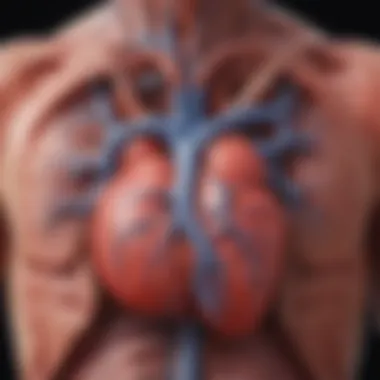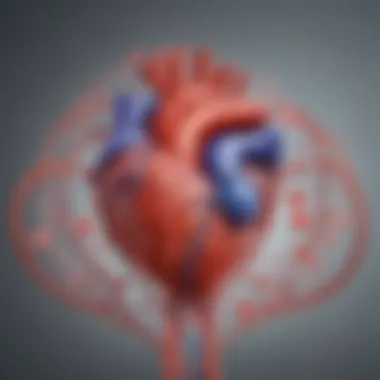The Link Between Heart and Kidney Failure Explained


Intro
The relationship between heart failure and kidney failure is one that continues to attract research attention. Understanding this connection is vital for health professionals and researchers alike, given the shared mechanisms and risk factors underpinning these conditions. Both heart failure and kidney failure can often coexist, complicating clinical management and impacting patient outcomes.
Physiologically, the heart and kidneys are interdependent organs. Dysfunction in one can lead to impairment in the other. The dual pathology of these diseases presents a significant challenge in patient care. Thus, exploring their interconnection is not merely an academic exercise; it has profound implications for treatment strategies and health management.
This article aims to provide an in-depth analysis of this complex interplay. From shared pathophysiological mechanisms to the latest research trends, we will navigate the intricacies of heart and kidney health, offering insights that may inform clinical practice and enhance patient care.
Prelims to Heart Failure
Heart failure is a major public health concern that affects millions worldwide. It is essential to comprehend this condition to explore the interconnectedness it shares with kidney failure. Understanding heart failure lays the groundwork for grasping the complexities found in patients suffering from both conditions. It also highlights the importance of timely diagnosis and management strategies that can significantly improve patient outcomes.
The significance of studying heart failure originated from its implications on health systems and society. Heart failure contributes to increased morbidity, mortality, and healthcare costs. It is not merely a condition but a syndrome that can manifest in various ways, shaped by individual health profiles and risk factors.
Definition and Types of Heart Failure
Heart failure is defined as the heart's inability to pump blood effectively to meet the body's needs. This inefficacy can stem from issues like increased pressure in blood vessels, weakened heart muscle, or improper heart rhythm. Generally, it is categorized into two types:
- Heart Failure with Reduced Ejection Fraction (HFrEF): Here, the heart's pumping efficiency is significantly reduced.
- Heart Failure with Preserved Ejection Fraction (HFpEF): In this scenario, the heart maintains a normal pumping function but fails to relax properly.
Both types have distinct pathophysiological mechanisms and often coexist in patients, complicating treatment.
Pathophysiology of Heart Failure
The pathophysiology of heart failure involves complex interactions between various systems of the body. Initially, the body attempts to compensate for heart abnormalities through neurohormonal activation. This leads to increased levels of hormones like norepinephrine and renin-angiotensin-aldosterone. However, over time, these compensatory mechanisms become maladaptive, contributing to further heart deterioration.
Factors such as chronic ischemia, hypertension, and valvular heart disease can exacerbate heart failure. These processes can lead to structural changes in the heart and surrounding tissues, ultimately affecting overall heart function.
Prevalence and Risk Factors
Heart failure is a prevalent condition globally, with millions diagnosed each year. The risk factors include:
- Coronary artery disease
- Hypertension
- Diabetes mellitus
- Obesity
- Sedentary lifestyle
- Tobacco use
Socioeconomic factors can also play a critical role in heart failure prevalence. Understanding these aspects is crucial, as they inform targeted prevention and management interventions. By recognizing the significance of these risk factors, healthcare providers can improve screening and treatment strategies to mitigate the effects of heart failure.
Understanding Kidney Failure
Kidney failure is a profound health issue that significantly impacts patient well-being and necessitates a comprehensive understanding. This section delves into the definition, stages, pathophysiology, prevalence, and risk factors associated with kidney failure. Understanding each of these elements helps underscore the critical interactions between kidney and heart health. The kidney's function is vital for maintaining fluid balance, electrolytes, and waste elimination. When its functionality diminishes, the repercussions can be systemic, influencing cardiovascular health and overall patient morbidity.
Definition and Stages of Kidney Failure
Kidney failure, also referred to as renal failure, occurs when the kidneys lose their ability to filter waste products from the blood effectively. There are primarily two types of kidney failure: acute and chronic.
Acute kidney failure arises suddenly and often can be reversible with prompt treatment. It may occur due to various causes such as dehydration, acute injury, or severe infection.
Chronic kidney failure is a gradual decline in kidney function over months or years. It typically progresses through five stages:


- Stage 1: Normal or increased kidney function but with signs of kidney damage.
- Stage 2: Mild decrease in kidney function, with some loss of function.
- Stage 3: Moderate decrease in function, requiring more consistent medical management.
- Stage 4: Severe decrease in function, preparing for dialysis or transplant intervention.
- Stage 5: End-stage kidney failure, necessitating dialysis or kidney transplant for survival.
Understanding these stages is essential for timely intervention and management strategies to preserve kidney function.
Pathophysiology of Kidney Failure
The pathophysiology of kidney failure encompasses a variety of complex mechanisms. Damage to the kidney can result from intrinsic factors, such as glomerular filtration issues or tubular injury. Dysfunction of the nephrons, the functional units of the kidneys, leads to disruptions in the renal filtration process. As a result, waste products accumulate, and important electrolytes become imbalanced. This situation creates a cascade of physiological changes, ultimately affecting the heart, as it must work harder to pump blood, often leading to heart failure. Understanding these physiology aspects illuminates the necessity to consider both kidneys and heart conditions simultaneously.
Prevalence and Risk Factors
Kidney failure is more common than many might realize. According to various studies, millions of individuals worldwide face chronic kidney disease, with a significant portion progressing to kidney failure. The risk factors for kidney failure can be categorized into controllable and uncontrollable factors:
- Controllable factors include hypertension, diabetes, and lifestyle choices such as smoking and poor diet.
- Uncontrollable factors encompass age, family history of kidney disease, and certain coexisting medical conditions.
Understanding these risk factors assists healthcare professionals in developing targeted strategies for prevention and early detection of kidney failure.
Key Insights: It is critical to identify individuals at risk for kidney failure early. Interventions can help limit progression and improve long-term health outcomes.
By examining kidney failure thoroughly, we lay the groundwork for appreciating its interplay with heart health in the broader context of patient care.
The Heart-Kidney Connection
The connection between heart failure and kidney failure is a crucial area of medicine. Understanding this relationship sheds light on risk factors and treatment strategies that could improve patient outcomes. Heart and kidneys work together, influencing each other's function. Disruption in one organ often leads to complications in the other. This connection highlights the importance of considering both conditions in clinical practice.
Physiological Interaction between Heart and Kidneys
The heart and kidneys are integral components of the body’s circulatory and excretory systems, respectively. The heart pumps blood through the renal arteries to the kidneys, facilitating the filtration of blood and regulation of fluid balance. When the heart fails, decreased blood flow affects the kidneys' ability to filter waste products. This can lead to a condition known as cardiorenal syndrome, where kidney function declines due to head issues.
Conversely, kidney failure can lead to fluid overload, raising blood pressure, and increasing the workload on the heart. The interaction creates a vicious cycle. In this way, understanding how they affect each other is essential for managing both conditions effectively.
Common Pathways and Mechanisms
Several pathways govern the interaction between heart and kidney disease. Both conditions share various common risk factors, such as hypertension and diabetes. These factors can lead to the activation of neurohormonal systems like the renin-angiotensin-aldosterone system, which exacerbates both kidney and heart issues.
Inflammation is another common pathway. Elevated inflammatory markers may worsen the function of both organs. Moreover, oxidative stress, caused by an imbalance between reactive oxygen species and antioxidants, plays a role in both heart and kidney pathophysiology. By addressing these mechanisms, healthcare providers can devise treatments that target both conditions simultaneously.
Impact on Patient Health Outcomes
The interplay between heart and kidney health can significantly impact patient outcomes. Individuals with concurrent heart and kidney failure often experience poorer health status and reduced quality of life. Studies indicate that co-occurring conditions are linked with higher morbidity and mortality rates.
Management strategies need to focus on addressing both conditions. This dual approach can enhance overall health outcomes. A study published in the Journal of the American College of Cardiology shows that patients receiving integrated care for heart and kidney issues had improved outcomes compared to those treated for one condition in isolation.
"The interconnectedness of heart and kidney health cannot be overstated. Addressing both simultaneously is pivotal in enhancing patient care."
In summary, the heart-kidney connection is a vital aspect of understanding the complexities of these organ systems. Identifying their interconnections helps in developing effective treatment strategies that can improve patient outcomes and foster a holistic approach to healthcare.
Clinical Implications of Concurrent Heart and Kidney Failure


The co-existence of heart failure and kidney failure in patients presents a significant clinical challenge. Understanding the implications of managing these dual conditions is crucial for effective treatment and improved patient outcomes. The interplay between the heart and kidneys complicates both diagnosis and therapy, necessitating a comprehensive approach that integrates multiple facets of care. This section highlights the complexities and considerations in managing concurrent heart and kidney failure effectively.
Diagnosis Challenges
Diagnosing heart failure and kidney failure simultaneously can be particularly difficult due to overlapping symptoms. Both conditions may present with fatigue, fluid retention, and increased shortness of breath. Furthermore, laboratory tests and imaging studies can produce ambiguous results. For instance, elevated blood urea nitrogen and creatinine levels might suggest kidney impairment, but they may also indicate reduced cardiac output due to heart failure.
It is essential to carefully evaluate and differentiate the symptoms related to each condition. Clinicians must utilize a detailed history, physical examination, and appropriate diagnostic tools to reach a precise diagnosis. Moreover, timely identification is critical, as misdiagnosis can lead to inappropriate treatment and worsening of the patient’s overall condition.
Therapeutic Management Strategies
Managing patients with both heart and kidney failure requires a tailored approach that considers the unique pathology of each condition. Pharmacological therapy plays a significant role, but careful selection is essential. For example, diuretics are commonly used to manage fluid overload but must be used cautiously to avoid compromising kidney function.
Several key considerations guide therapeutic strategies:
- Medications: Heart failure patients often require ACE inhibitors, beta-blockers, and diuretics. In patients with concurrent kidney issues, the use of these medications should be monitored and adjusted to prevent kidney damage.
- Fluid Management: Striking a balance in fluid management is crucial. Over-restriction can lead to dehydration, whereas excessive fluid can exacerbate heart failure symptoms.
- Dialysis Consideration: In advanced cases, dialysis may become necessary. Coordination between nephrologists and cardiologists is vital to ensure optimal timing and management.
Continual monitoring of renal function throughout treatment is vital, along with using collaborative decision-making to modify regimens based on patient response.
Role of Multidisciplinary Care
Given the complexity of managing concurrent heart and kidney failure, a multidisciplinary team approach is vital. This team may involve cardiologists, nephrologists, nurses, dietitians, and pharmacists, working collaboratively toward shared goals. Each discipline offers unique insights and skills that enhance patient care.
A few advantages of this approach include:
- Comprehensive Assessment: This enables holistic evaluation, ensuring that both heart and kidney functions are considered in management strategies.
- Shared Expertise: Leveraging professionals from different fields fosters a comprehensive understanding of co-morbidities, which aids in individualized care plans.
- Improved Communication: A multidisciplinary setup ensures clear lines of communication among providers, enhancing the execution of treatment plans and patient education.
In summary, managing concurrent heart and kidney failure presents various challenges that require a sophisticated and collaborative response from the healthcare team. By addressing diagnosis challenges, implementing thoughtful therapeutic strategies, and embracing a multidisciplinary approach, clinical outcomes for patients can be significantly improved.
Current Research Trends
The intersection of heart failure and kidney failure has drawn heightened attention in recent years. This emphasis on current research trends reflects a deepening understanding of how these two conditions interact. Adopting a multi-faceted approach to research enhances not only our comprehension but also potentially improves patient management strategies. Focusing on advancements in diagnostics, therapeutics, and long-term studies is crucial. These areas highlight the evolving landscape in which healthcare professionals operate, aiming to increase the efficacy of treatments and outcomes for patients who experience this dual pathology.
Emerging Diagnostic Tools
Recent advances in diagnostic tools are at the forefront of research in heart and kidney conditions. Early and accurate diagnosis is fundamental to effective intervention. Technologies such as cardiac biomarkers and novel imaging modalities are reshaping how clinicians assess heart function and kidney health. For example, Troponin and BNP testing can indicate cardiac strain, while serum creatinine and cystatin C help evaluate kidney filtration. Integrating these tools enables a more comprehensive assessment of patients.
Moreover, point-of-care testing has emerged as a significant development. This allows for immediate results, reducing the time patients wait for critical information. Mobile health applications are also gaining traction, offering tracking solutions for symptoms and vital signs. This technology not only enhances communication between patients and healthcare providers but also fosters proactive management plans.
Another promising area is the use of artificial intelligence to analyze complex data sets. These algorithms have the potential to identify patterns that might elude traditional diagnostic methods, providing deeper insights into the heart-kidney connection.
Novel Therapeutics in Treatment
The development of novel therapeutics is significantly impacting the treatment landscape for patients with concurrent heart and kidney failure. Research is extending beyond traditional medications to include innovative approaches that target the underlying pathological processes shared by both conditions. Sodium-glucose cotransporter-2 inhibitors, such as empagliflozin and dapagliflozin, have shown promise in both heart failure and chronic kidney disease.
These agents improve heart function and renal outcomes by enhancing sodium excretion and promoting diuresis. Their ability to lower hospitalization rates for heart failure patients adds to their therapeutic value.
Additionally, research into gene therapy and regenerative medicine is paving the way for future treatment options. Gene editing techniques may address the genetic predispositions affecting heart and kidney health. Although this area is still in the early stages, it presents exciting possibilities for personalized medicine.


Longitudinal Studies and Findings
Longitudinal studies are paramount in deciphering the long-term implications of concurrent heart and kidney failure. Research that follows patients over extended periods offers insights into disease progression, treatment efficacy, and the impact of interventions on quality of life. These studies accumulate data that help identify critical risk factors and biological pathways linking the two ailments.
Findings from such studies reveal that early detection and management of one condition can significantly affect the other. For instance, effective heart failure management may slow kidney disease progression and vice versa. Moreover, they also underscore the importance of developing standardized treatment protocols catered to patients with both conditions.
Agile data management systems are facilitating this research by enabling seamless collaboration among clinics and research centers, leading to a richer understanding of patient responses over time. By synthesizing information from diverse patient populations, researchers can create a clearer picture of the heart-kidney axis, ultimately improving clinical practices for better health outcomes.
Future Directions in Heart and Kidney Research
The relationship between heart failure and kidney failure is increasingly recognized as a critical area for medical research. Understanding this connection has implications for patient care and treatment strategies. New findings in this area present opportunities to improve outcomes for patients suffering from these dual health challenges.
Potential for Biomarker Discovery
Research into biomarkers holds promise for advancing our understanding of heart and kidney interdependence. Biomarkers are measurable indicators of the severity or presence of a disease. Identifying specific biomarkers related to heart and kidney function could lead to earlier diagnosis and more tailored treatment plans.
- Cardiac Biomarkers: Such as natriuretic peptides, which can indicate heart strain.
- Renal Biomarkers: Like neutrophil gelatinase-associated lipocalin (NGAL), which shows acute kidney injury.
- Shared Biomarkers: Identifying biomarkers that reflect both cardiac and renal stress could provide insights into concurrent management strategies.
Genetic Studies and Implications
The role of genetics in the development of heart and kidney failure is gaining attention. Genetic studies may elucidate inherited traits that predispose individuals to these conditions. This is significant for several reasons:
- Personalized Medicine: Genetic profiling can help tailor treatment to individual patients, improving effectiveness.
- Risk Identification: Understanding genetic risk factors can lead to early intervention strategies for high-risk populations.
- Pathway Mapping: It may reveal biological pathways that are common to both heart and kidney diseases, identifying potential therapeutic targets.
Integration of Technology in Research
Advancements in technology are reshaping how research on heart and kidney failure progresses. The integration of technology can create innovative opportunities:
- Data Analytics: Big data tools can analyze large patient populations, uncovering trends and correlations between heart and kidney health.
- Wearable Health Devices: These can monitor patient vitals in real-time, providing essential data for both preventive care and active management.
- Telehealth Innovations: Remote patient monitoring and consultations can enhance follow-up care, especially important for patients with limited mobility or access to healthcare facilities.
"The understanding of heart-kidney interdependence will not only aid in treatment strategies but can also pave the way for future preventive measures."
The strides taken in these areas underscore a collective effort to address the complexities of heart and kidney failures, directing future research toward more effective interventions and improving patient outcomes.
Ending
The interrelationship between heart failure and kidney failure is a critical area of focus in medicine. Understanding this connection allows for improved patient outcomes and better management of both conditions. As the two organs depend on each other for optimal function, recognizing this interdependence is vital in clinical practice.
Summary of Key Insights
Several key insights emerge from this exploration of heart and kidney failure.
- Physiological Interdependence: The heart and kidneys communicate through various mechanisms, leading to a feedback loop that can exacerbate conditions in both organs.
- Shared Risk Factors: Factors like hypertension, diabetes, and obesity play a substantial role in the development of both heart and kidney diseases.
- Clinical Management: Awareness of simultaneous heart and kidney issues can lead to more effective diagnostic and therapeutic strategies, involving both organ systems.
This holistic view is increasingly recognized as essential in treating patients with chronic illness.
Importance of Awareness and Understanding
Raising awareness about the link between heart failure and kidney failure is crucial for several reasons:
- Integrated Care: Acknowledging the connection promotes an integrated approach to patient care, enhancing the effectiveness of treatment plans.
- Patient Engagement: Patients informed about these connections are more likely to engage in their health management, leading to better adherence to treatment.
- Research and Innovation: Increased awareness can drive research funding and innovation in treatments, ultimately aiming to improve patient outcomes in both heart and kidney diseases.
In summary, a comprehensive understanding of the heart-kidney axis not only benefits clinical practice but also fosters patient education and sets the stage for future research.



